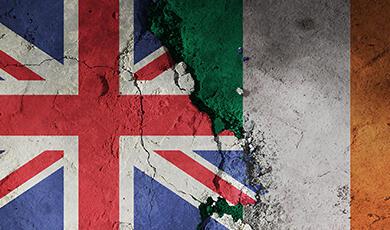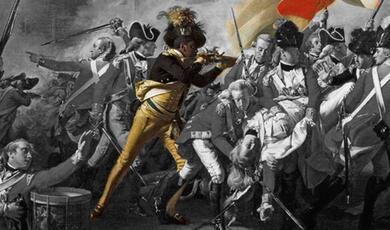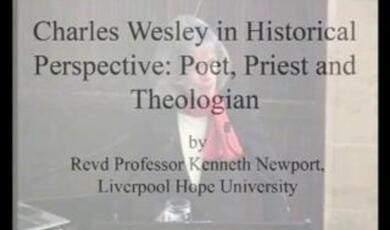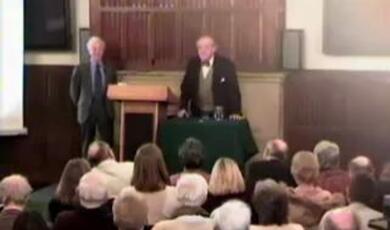Heading for Trouble: The perils of navigation
Share
- Details
- Transcript
- Audio
- Downloads
- Extra Reading
This lecture was a part of the SeaBritrain2005 series of events, which celebrated the ways in which the sea touches all of our lives.
Download Transcript
Tony Mann
First, let me say what a very great honour it is to be invited to talk at Gresham College. It’s especially a pleasure since I am particularly aware, because of my interest in seventeenth-century mathematics, of the major role played by Gresham College in the development of my subject. It is also somewhat daunting, because I have attended so many fascinating and stimulating lectures here, not least those in this present series given by Tim Severin, Alan Stimson and Tim Connell, who are a hard trio to follow
Over the last month we’ve heard from Tim Severin a first-hand account of the physical experience of trail-blazing navigation in his talk about theBrendan voyage; Alan Stimson has told us about the development of the tools and instruments used by navigators over the last millennium; and Tim Connell’s virtuoso performance last week discussed, amongst many other things, the challenges faced by intrepid explorers in the most inhospitable areas of the globe. What I am going to talk about today is the intimate interaction between the theory of navigation and its practice: in particular how the incomplete understanding that we have during the development of navigational science inevitably leads to errors; how brave navigators trusting their lives to untested theories found themselves in peril and how their sometimes disastrous experiences led to improvements and corrections in our understanding of our world.
I’m a mathematician (but there won’t be much maths in this talk) so I’m naturally particularly interested in the contributions to navigation made by practitioners in my subject. One of the first English books on the mathematics of navigation (and a very good one) was by a gunner and mathematical tutor from Gravesend, William Bourne, whose A Regiment for the Sea of 1574 begins with a particularly helpful piece of advice: ‘The first & most principall thing for any seafaring man or traueller, is to know toward what part of the Earth he meaneth to go.’ So perhaps I should follow this excellent advice and begin by giving some idea of the ground we shall be covering during the next forty-five minutes.
On 30th October 1939 Winston Churchill was in conference with the First Sea Lord and the Commander-in-Chief of the Home Fleet on board HMSNelson when the ship was struck by two torpedoes from a German submarine. Had these torpedoes exploded, history might have been rather different, but in fact they both failed to detonate, and the reason for this was a phenomenon which had caused problems for Christopher Columbus almost 450 years before, and which continued to trouble navigators throughout the intervening period. This will be one of the sources of peril that we’ll be investigating.
The belief in the existence of a navigable North-West passage from the Atlantic to the Pacific led to an intensive search over three centuries by British explorers. We’ll be examining why there should have been such a strong belief, erroneous as it turned out, that such a passage must exist.
And I’ll be talking about what must be the largest navigational miscalculation ever made, one which is not yet understood but which might change our understanding of the nature of the whole universe.
I’m more interested in error than in straightforward incompetence: there are plenty of examples of the latter throughout the history of navigation (and every other human activity), but this talk is more concerned with mistakes made ‘in good faith’, those which illustrate how knowledge develops and how we learn from the errors and inadequacies of our theories. And of course navigation and exploration themselves provide helpful metaphors for the growth of scientific knowledge. Indeed the spiritual father of the Royal Society, Francis Bacon, used navigational images in his frontispieces. Famously that for The Great Instaurationshowed ships sailing beyond the Pillars of Hercules from the known world to the unknown, and my illustration is the perhaps less well-known frontispiece for the posthumously published Sylva Sylvarum, in which we see the Pillars flanking a globe showing Europe, Africa and America, and inscribed ‘Mundus Intellectualis’, ‘the world of understanding’. This metaphor underlying Bacon’s frontispieces has been profoundly influential in shaping the way we have thought of science since the seventeenth century.
From the first, sailors have used all sorts of aids to navigation. We think of the compass (which, although it was known much earlier to the Chinese, who used it mainly for feng shui, seems to have become a primary navigational tool first in the Mediterranean in medieval times) and the stars. But there are other ways to find direction. Sailors could tell from the qualities of the wind – its strength, consistency, warmth – from which direction it was blowing (which is why the winds feature instead of or in addition to the compass rose on so many maps). Sailors could follow the route of migrating birds. And cloud formations can indicate nearby land – which was something you will recall Tim Severin made use of during the Brendan voyage. Navigators in many parts of the world must have developed their own extremely sophisticated and effective methods: but in this talk I’m only considering Western instrumental navigation.
If you’re in unknown territory, there are two ways you can establish your position. You can calculate it directly by using instruments to find out exactly where you currently are, or you can obtain it indirectly by working out how far you have travelled, and in what direction, from your known starting point. This latter art of ‘dead reckoning’ has resulted in many remarkable achievements. Since this is Black History Month, I’d like to mention the remarkable explorer Matthew Henson, who, in April 1909 on the last stage of the journey, when clouds obscured the sun, navigated himself and Peary by dead reckoning to within three miles of the north pole, before the clouds cleared and they could check their position and became the first to be, as Hewson wrote, ‘on the top of the world’: we see here both the indirect and direct methods being used. (I should add that the question of Peary’s and Henson’s achievement is controversial.) Mathematics and instruments for both kinds of calculation were developed in the West. Instruments like the quadrant, cross-staff and GPS device are used to establish one’s position directly, while the compass and log were the basis for dead reckoning at sea. These instruments were perfected by the interaction between the instrument-makers, the theorists and the travellers.
Perhaps the best-known navigational miscalculation of all was that of Christopher Columbus, who took to be the East Indies the islands we now call, as a result of his mistake, the West Indies. This is an instructive story. The version which I was taught in primary school was that, at a time when everyone believed the world to be flat, Columbus knew it was spherical. He therefore thought it was possible to sail west from Europe to the Indies. He set off in his three small ships in the face of ridicule from all sides because everyone else believed that the ships would sail over the edge of the world and be lost for ever. But he returned in triumph and the doubters were proved wrong: a classic story of the triumph of truth over ignorance.
This version is, of course, wrong in every essential aspect. In the fifteenth century, and for centuries before, there was virtually nobody who believed in a flat earth. (Observation of ships gradually disappearing below the horizon was strong everyday visual evidence of curvature!) So everyone knew the earth was spherical: there was however uncertainty over its diameter. Most believed that, though it was theoretically possible to get to the Indies by sailing west, the earth was so large that ships could not carry enough food and water, and the crew would inevitably die of thirst and starvation before getting there. Columbus argued that the earth was much smaller than generally supposed, and so he believed that such a voyage was practical. In fact Columbus was wrong and the accepted view was correct. Fortunately for him, he came across a hitherto unexpected continent before his supplies were exhausted.
The popular version of the Columbus story originated with the American writer Washington Irving in the early nineteenth century and seems to have become established later in that century. It’s an example of our human desire for simplicity and a clear moral driving out a more complex truth. The former Gresham Professor of Geometry Ian Stewart and his colleague Jack Cohen talk about ‘lies-to-children’: the helpful but not entirely accurate stories that teachers need to use to prepare the mind for a more truthful version that is too complex to present initially. I think the Columbus myth has a wonderful moral value even if it misrepresents history.
We’re all familiar with the story of how Columbus sailed for the Indies and found America. A less familiar tale is that of the English expedition of 1553, when three small ships set sail, hoping to reach China by a route around the north of Europe. The unforeseen outcome was an unexpected arrival in Russia, the establishment of a valuable trading route to Russia, and the foundation of the Muscovy Company. This route was found by Richard Chancellor in the Edward Bonaventura. The other two ships had been separated from the Bonaventura during a storm, and their pioneering exploration of northern waters ended in tragedy at the so-called ‘Haven of Death’, where the crews were subsequently found dead. At the time they were thought to have suddenly frozen to death, but a more recent suggestion is that they died of carbon monoxide poisoning while burning sea-coal with the hatches battened down. This expedition had been equipped with the most up-to-date navigational aids, and had been briefed with the latest geographical information by the mathematician John Dee, who also provided new mathematical tables. The difficulties faced by mariners who had access to even the most expert advice are shown by a rueful comment found in diary of the leader of the ill-fated expedition, Sir Hugh Willoughby, who wrote, ‘The land lay not as the globe made mention.’
(Incidentally, if you are interested in Tudor navigation, Stephen Johnston’s forthcoming lecture here on 3 rd November on the instruments recovered from the Mary Rose will be fascinating – that’s the annual lecture organised jointly with the British Society for the History of Mathematics.)
Alan Stimson talked of the importance of the compass, and mentioned some of the difficulties associated with it. Columbus had problems with his compasses during his voyages:
‘The pilots took the north, marking it, and found that the compasses northwested a full point; and the sailors were fearful and distressed. The Admiral ordered that the north again be marked when dawn came, and they found that the compasses were correct. The cause was that the North Star appears to move and not the compasses.’
Of course the North Star does not move (or at least, not very much): what appears to have been the problem is a mixture of two effects which we now call compass ‘variation’ and ‘deviation’. The changes in readings recorded by Columbus, when the needle’s angle depended on the time of day, are thought to have been due to attraction to iron objects near the compass, which we call ‘deviation’. But Columbus would also have experienced ‘the variation of the compass’. The earth’s magnetic field varies, and so, as you move a compass round the globe, the direction it indicates, relative to true north, changes. Sailors and mathematical writers soon became aware of this problem. The seventeenth century writer Richard Norwood, ‘Reader of the Mathematicks’, wrote,
‘He that diligently obserues the variation, findes (as I say) no prejudice in it, onely it requires dayly, or once in two or three dayes halfe an houres worke, and this labour it doth abundantly recompense; for by this meanes he knows at the present how to direct his Course, and for the future… he knows when he drawes neare to any of those places where such observations were made, and so falls the more certainly with any place intended.’
We see here a very resourceful attitude, recognising not only the difficulties posed by this physical phenomenon, but also its value as an aid to finding position. Indeed, it was hoped that variation might even provide the solution to the major outstanding navigational problem of the time, how to calculate one’s longitude at sea. William Barlowe wrote in 1597 of the ‘knowledge of the Variation of the Compasse; yea besides the particular knowledge of Places, the expert Nauigator standeth in great hope hereby to attaine unto good helpes for the finding of Longitudes’.
The discovery however that compass variation was dependent not just on place, but also changed over time, complicated matters. Alan Stimson mentioned the contribution to navigation of the seventeenth-century Gresham Professor of Astronomy, Edward Gunter. It was Gunter’s successor at Gresham College, Henry Gellibrand, who in 1633 showed that magnetic variation in London had changed by fully 15 degrees in the fifty-odd years since 1580. This put paid to any immediate hopes that compass variation could be the key to the longitude problem.
The problem of compass variation was closely studied at the close of the seventeenth century by the future Astronomer Royal Edmond Halley, who drew up a chart showing the variation around the Atlantic. He formulated a long-lasting theory that the earth consisted of a magnetic surface layer moving relative to a core, which was also magnetic. (Rather less long-lasting was Halley’s belief that the gap between these two layers was inhabited, and that God had provided a special kind of light and atmosphere to support those living there!) Halley’s chart of magnetic variation introduced the concept of joining points of equal measurement. These lines were known until the nineteenth century as ‘Halleyan Lines’ and are now called ‘isogonics’: they are very familiar to us from weather maps. Halley’s chart, impressively detailed though it looks, is based on only 150 readings and so there is a fair amount of speculation involved in the construction of some of the lines!
Compass variation wasn’t the only reason compasses couldn’t always be relied on: ‘deviation’ remained a problem. Edward Wright wrote in 1599,
‘Exact trueth amongst the unconstant waues of the sea is not to bee looked for, though good instruments bee neuer so well applied… Causes of error herein, some cannot be auoyded, as the vnsteadinesse of the ship, the imperfection of sense & instruments, the weake respectiue force of the needle or wires, be they neuer so wel touched. Others may be eschewed, as that there be no iron neare the Compasse in time of obseruation…’
Seamen seem to have been surprisingly careless of the danger that the compass reading could be affected by iron on the ship. The compass was housed in the binnacle, which might be held together by iron nails, and which provided a convenient place to store muskets or pistols containing iron.. Even the great Captain Cook kept the keys to the ship’s leg-irons in the binnacle (and complained in his diary of the inconsistency of his compasses).
Compass deviation became even more problematic when shipbuilders began to build iron ships. The action of the earth’s magnetic field during the building of an iron-hulled ship would result in the hull itself becoming magnetised. This would affect the compass readings on board, in a manner dependent on the direction in which the ship had lain during building! In 1831 the new iron-built Lord Dundas left Liverpool on its maiden voyage to the Isle of Man. When it didn’t arrive on schedule, there was considerable concern: when it subsequently turned up, it transpired that the ship’s course, following the compass heading for Douglas, had instead taken it to Morecambe Bay. The compass needle had been affected by the metal in the ship’s hull and its readings were out by 50 degrees! And there were tragic examples such as the loss of the iron-hulled Tayleur on its maiden voyage to Melbourne in 1854, wrecked on rocks near Dublin with the loss of 350 people, because of compass error. The ship’s two compasses had differed by two points (over 20 degrees) and the Captain had chosen the wrong course as a result. There were great debates in the nineteenth century over technical solutions to the problems of compass deviation, with the Astronomer Royal George Airy particularly prominent in controversy. Later William Thomson, Lord Kelvin, made a fortune from the Thomson compass, which was adopted by all the British shipping companies and became the standard compass for the Royal Navy in 1889 (after a very effective marketing campaign by Kelvin).
And you may remember my reference to the German torpedoes which didn’t sink HMS Nelson in the North Sea in 1939. Why didn’t they go off? The Germans had developed a new method of detonating torpedoes, so that rather than explode on impact with the target, they would detect the magnetism of the target’s hull and detonate underneath the ship. Unfortunately for them, their tests had taken place further south, and took no account of magnetic variation. So at the higher latitude the difference in the earth’s magnetic field affected the mechanism and there was no detonation. Even after 450 years it was still possible to forget to take account of magnetic variation!
Tim Connell last week told us about Franklin and the North-West Passage. Why was there such a strong belief in Britain, for three centuries, from Frobisher to Franklin, that a navigable north-west passage from the Atlantic to the Pacific should exist, when we know now that it doesn’t? Over the centuries there were various arguments for this belief, from Biblical analysis about how the human race had spread around the globe from the Garden of Eden, to claims that symmetry required a strait to match the Strait of Magellan in the south. But there were also reasons adduced that we would now regard as more plausible, based on currents and tides. The first Gresham Professor of Geometry, Henry Briggs, who was a member of a trading company, wrote in 1622 of ‘very great probability, if not full assurance’ of the existence of a passage to the Pacific from Hudson’s Bay:
‘in the place where Sir Thomas Button did winter in 57 degrees of latitude, the constant great tides euery twelue houres, and the increase of those tides whensoever any strong westerne wind did blow, doe strongly perswade vs that the maine Westerne Ocean is not farre from thence; which was much confirmed vnto them the summer following; when sayling directly North from that place where they wintered, about the latitude of 60 degrees, they were crossed by a strong Currant running, sometimes Eastward, sometimes Westward: So that … wee may assure our selues that from thence we may with great ease passe to any part of the East Indies.’
and Briggs published a map of North America showing (somewhat sketchily) where this passage might be.
In the eighteenth century the Irish MP Arthur Dobbs was making similar arguments based on Luke Foxe’s 1631 observations of eighteen-foot tides in the west of Hudson Bay compared with six-foot tides in the middle of the Bay. Apparently plausible arguments such as these, based however on limited understanding of tides and currents and perhaps on a lack of realism about the quality of measurement possible on board ship in heavy seas, led to fruitless searches for a passage over three centuries. Optimism can cloud our ability to evaluate evidence, as we see from the writings of some English football journalists of today whose predictions of English success in the next World Cup seem to an impartial Scottish observer like me to ignore all the evidence.
Briggs’s map of north America has another interesting feature: on the Pacific Coast it shows ‘the Cape of California, which is now found to be an Iland.’ Many subsequent maps followed Briggs’s in showing California as an island: Briggs’s map is seen as the source of this long-persisting error. In 1705, Eusebio Kino walked from the ‘mainland’ to the ‘island’, but since this was clearly impossible (as any map would show) nobody believed his feat: California was still being shown as an island in maps in 1770. Perhaps the moral is that you should not believe everything you are told by a Gresham professor!
As has been hinted above, the longitude problem was perhaps the biggest difficulty facing navigators. Edward Wright writes of the standard method of ‘running down the latitude’ rather than seeking the shortest route:
I haue obserued that some of our masters take a wise course, in not trusting to those courses which are shewed by their charts. But first getting themselues into the height or paralel of the place to which they are going: and withal, knowing assuredly whether they be more eastward or westward than that place; they then proceed always heedfully keeping themselues under that parallel till they come to the place desired. Then which way of sayling there is none indeed more certaine and infallible for the sure finding of the place assigned.
The catch, of course, is in the phrase ‘knowing assuredly whether they be more eastward or westward’. Consider the problem faced by Anson in theCenturion on his great voyage of 1741. Having rounded Cape Horn, he desperately needed to reach Juan Fernández Island (which is now called Isla Robinson Crusoe) so that he could resupply. Being unsure of his longitude, because the strong currents he had faced had made dead reckoning unreliable, he adopted the usual method of running down the latitude. Anson successfully reached the correct latitude: but his problem then was that he did not know whether he was east or west of the island! Guessing that he was east of it, he sailed west, but after four days when there was no sign of the island he concluded that he had been wrong in his guess. He therefore changed course by 180 degrees and sailed back along the parallel. Several days of sailing due east duly brought sight of land, but it was the hostile coast of Chile ! He had to change course again, and sail back westwards: the island had been only a few hours away when he had first changed direction. It has been estimated that the resulting fortnight’s delay cost the lives of eighty sailors to scurvy. Such digressions and reversals were an inevitable consequence of the longitude problem: the story of its eventual solution, whether by Harrison’s expensive chronometer or by the cheaper method of Lunar Distances in conjunction with the Nautical Almanack, is well known.
I now want to jump a long way forward to more recent mathematical developments. This is the centenary year of Einstein’s publication of his Special Theory of Relativity. I mentioned earlier the ‘lie-to-children’ version of the Columbus story that I learned in primary school. When, as a schoolboy, I first came across Relativity, it seemed very hard to understand. But I was reassured when my teachers told me that, although it was an elegant and important mathematical theory and essential for astronomers and cosmologists, for all practical purposes in everyday life on earth it was irrelevant: Newton’s model of the workings of the universe and traditional Euclidean geometry were enough for anything that might ever concern me. Well, again my school-teachers were wrong. There have been a couple of references in previous lectures to satellite navigation and the Global Positioning System: indeed, some of you may have found your way here today using a tiny portable GPS device (and some intending to come may still be wandering lost round the streets of London because they don’t have one!) GPS devices are capable of astonishing accuracy (and of serious error if you input the wrong data, as has unfortunately been the case on a number of occasions when they have been used to guide bombs, and no doubt very often in situations with less serious consequences). And the GPS system depends on relativity theory: Newtonian calculations would give the wrong answer. So relativity theory is another example of a mathematical discovery, initially abstruse and theoretical, which has turned out to have valuable applications in everyday life.
And that late 20th century technology brings me to my final example. I promised you the greatest navigational miscalculation ever made. In 1972 and 1973 the space probes Pioneer 10 and Pioneer 11 were launched, heading for Jupiter and Saturn respectively. Both probes completed their intended missions successfully, and having made their observations of the target planets they have been following trajectories which have taken them to the opposite ends of the solar system. Pioneer 10 became the first human artefact to leave the solar system in 1983 when it passed beyond the orbit of Pluto. But both probes continued to send back information about their positions until the transmission system of Pioneer 11 failed in 1991: the last message from Pioneer 10 was received on February 11, 2000.
Although their missions had been completed, the positional data that was continuing to come from the Pioneers was recorded and compared with the expected trajectories calculated by the astronomers. And the scientists were surprised to find that the probes were not moving as we had calculated that they should. Both probes were exhibiting a tiny but unpredicted acceleration towards the sun. And our current theories of dynamics can offer no satisfactory explanation for this acceleration. Astronomers seem to be sure that there is no observational error, and that there is no plausible mundane explanation, such as possible gas leaks from the probes, that has not been taken into account. Various ideas have been put forward, including dark matter, dark energy, unexpected matter in the Kuiper belt, errors in relativity theory, or a need for new physics. More recent missions aren’t likely to provide any new data that might help. (There are a lot of old data from previous missions that might shed some light, but they are stored on old-format magnetic tapes from which they cannot easily be retrieved as the tape readers may no longer exist.) So the problem remains unsolved.
The lesson I would like to draw from the Pioneer Anomaly is that, even if the location in which we are navigating has changed, navigation, and our failure to calculate exactly where we are, is continuing to give us information about our level of understanding of the universe, and to bring to our notice the weaknesses in our scientific theories. From Columbus to Pioneer, we see that our theories inspire voyages which may not always have the expected result, and that the mismatches between predictions and outcome inspire improvements and refinements in our theories, and are an essential part of the process of expanding our knowledge. And, of course, these mismatches also inevitably in the past brought travellers into danger on the world’s oceans, which naturally brings us to the topic of the Mondays at One series here next term, “For those in peril on the sea”.
Thank you.
Sources:
John D. Anderson, Philip A. Laing, Eunice L. Lau, Michael Martin Nieto, and Slava G. Turyshev, ‘The Unfinished Quest to Solve the Pioneer Anomaly’, The Planetary Society, http://www.planetary.org/news/2005/pioneer_anomaly1_0510.html (consulted 21/10/2005)
W. Barlowe, The Navigator’s Supply, Conteining many things of principall importance belonging to Nauigation (London: G. Bishop, 1597; Amsterdam: Theatrvm Orbis Terrarum, 1972))
William Bourne, A Regiment for the Sea (London: Thomas Hacket, 1574: Cambridge: Hakluyt Society (ed. by E.G.R. Taylor), 1965)
Anna Brendle, ‘Profile: African-American North Pole Explorer Matthew Henson’, National Geographic News, http://news.nationalgeographic.com/news/2003/01/0110_030113_henson.html (consulted 21/10/2005 )
A.D. Burnett, ‘The Engraved Title-Page of Bacon’s Instauratio Magna’, Durham Thomas Harriot Seminar Occasional Paper 27 (Durham: Thomas Harriot Seminar, 1998)
Henry Briggs, ‘A Treatise of the Northwest Passage to the South Sea, through the Continent of Virginia and by Fretum Hudson’ annexed to Anonymous, A Declaration of the State of the Colony and Affaires in Virginia (London: Robert Mylbourne, 1622); reprinted with a map in Samuel Purchas, Purchas his Pilgrimes (London: Henrie Fetherstone, 1625)
Oliver Dunn and James E. Kelley, Jr., The Diario of Christopher Columbus’s first voyage to America 1492-1493 (Norman: University of Oklahoma Press, 1989)
Patricia Fara, Fatal Attraction: magnetic mysteries of the Enlightenment ( Cambridge: Icon, 2005)
Alan Gurney, Compass: a story of exploration and innovation ( New York: Norton, 2004)
Richard Hakluyt, Voyages and Discoveries (London: Penguin, 1972)
Kit Mayers, North-east passage to Muscovy: Stephen Borough and the first Tudor explorations (Stroud: Sutton, 2005)
Richard Norwood, The Sea-mans Practice, Contayning a Fundamental Probleme in Navigation, experimentally verified ( London: George Hurlock, 1637)
Geoffrey Regan, The Guinness Book of Naval Blunders (Enfield: Guinness, 1993)
Jeffrey Burton Russell, Inventing the flat earth: Columbus and modern historians (New York: Praeger, 1993)
Seymour I. Schwartz, The mismapping of America ( Rochester: University of Rochester, 2004)
Lez Smart, Maps that made history ( Kew: National Archives, 2004)
Dava Sobel and William J.H. Andrewes, The illustrated Longitude (London: 4 th Estate, 1999)
Clifford M. Will, ‘Einstein's Relativity and Everyday Life’, Physics Central, http://www.physicscentral.com/writers/writers-00-2.html (consulted 21/10/2005 )
Glyn Williams, Voyages of Delusion: The Search for the North WestPassage in the Age of Reason ( London: HarperCollins, 2003)
J.E.D. Williams, From sails to satellites: the origin and development of navigational science (Oxford: Oxford University Press, 1992)
E. Wright, Certaine Errors in Navigation ( London: Valentine Sims, 1599)
© Tony Mann, Gresham College, 24 October 2005
This event was on Mon, 24 Oct 2005
Support Gresham
Gresham College has offered an outstanding education to the public free of charge for over 400 years. Today, Gresham plays an important role in fostering a love of learning and a greater understanding of ourselves and the world around us. Your donation will help to widen our reach and to broaden our audience, allowing more people to benefit from a high-quality education from some of the brightest minds.


 Login
Login







